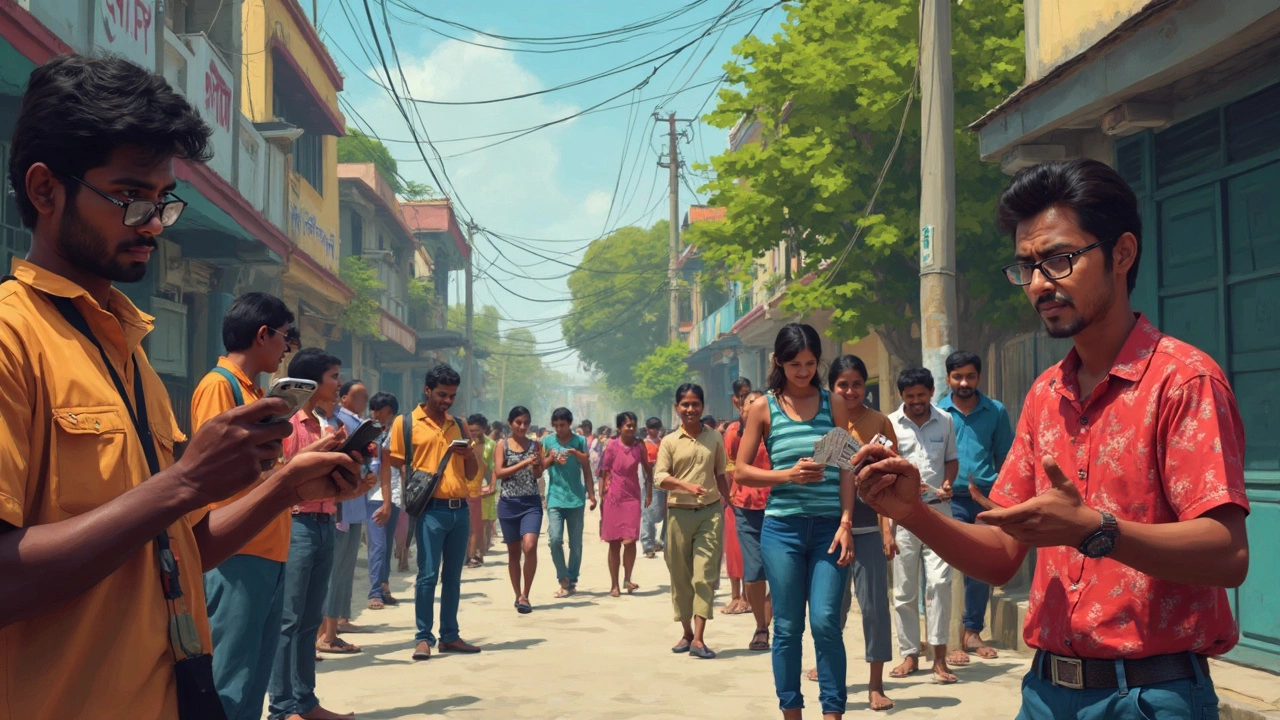Ever notice how lending a hand doesn't seem as common as it used to be? That's because volunteering is on a bit of a downswing these days, and it's leaving a noticeable gap in communities everywhere. There are many reasons why hitting that 'volunteer' button is becoming rarer, and it goes beyond just a busy schedule or a lack of interest.
One big reason is the economic pressures that folks are facing. With costs spiraling and job security feeling like a distant dream, many people are prioritizing paid work over unpaid volunteer gigs. It’s hard to commit to community work when you’re hustling just to keep your head above water.
- The Current State of Volunteering
- Economic Pressures and Volunteering
- Impact of Digital Life on Community Engagement
- The Importance of Volunteering for Community Health
- Barriers to Volunteering
- Tips to Revitalize Volunteering Efforts
The Current State of Volunteering
Right now, the world of volunteering is facing some challenges, and it's more than just a casual dip. Various factors are causing this shift, and understanding them can help us figure out how to get folks back into the swing of community service.
Over the past decade, statistics show that volunteering in many countries has declined. According to a recent survey, participation rates in traditional volunteer roles have fallen by about 10% since 2020. Even some local charities, which have relied on extra hands, are feeling the pinch, reporting volunteer shortages during crucial events.
One reason for this downturn might be demographic changes. Younger generations, particularly Millennials and Gen Z, are participating less in formal community service, although they often engage in activism or digital volunteering. Their style of contributing is different from previous generations who mostly preferred in-person commitments.
Moreover, the perception of volunteer opportunities has evolved. Many people today are looking for short-term or project-based roles rather than long-term commitments. This reflects a broader shift in how people value flexibility in all areas of life, including work and leisure.
Another contributing factor is the growing appeal of digital life. With so much time spent online, finding time for offline activities, like volunteering, becomes less of a priority for many. As people become more digitally engaged, traditional community service feels like an investment of time they can't afford.
Understanding these trends is crucial for community organizations aiming to adapt and modernize their volunteer programs. This way, they can attract a wider pool of volunteers by offering diverse and flexible roles that fit into today's busy lifestyles.
Economic Pressures and Volunteering
These days, it feels like everyone is talking about rising living costs, and for a good reason. One major factor in the volunteering decline is economic pressure. When you're juggling rent, groceries, and maybe even school fees, volunteering might drop down your priority list.
Consider this: The cost of housing has skyrocketed, especially in city spaces like Sydney. Folks are working longer hours or picking up multiple jobs just to pay the bills. So, squeezing in unpaid volunteer hours can seem like a luxury some just can't afford right now.
There's also the tricky situation of underemployment—a lot of people have jobs that aren't using their skills fully, but the pay isn't great either. This grind for survival can leave little room for community service no matter how noble the cause.
Let's not forget about wages. They've been stagnant for years, even as inflation does its thing. Stretching a dollar has never been harder, forcing many to focus on gigs that pay the bills over those that feed the soul.
It's not that people don't care—the will to help is there. It's just that financial stress can overshadow the intent to support a communal effort. Understanding this dynamic is crucial in finding ways to boost volunteer opportunities.
| Year | Average Increase in Living Costs | Volunteer Participation Rate |
|---|---|---|
| 2020 | 2.8% | 25% |
| 2021 | 3.2% | 23% |
| 2022 | 3.5% | 21% |
Impact of Digital Life on Community Engagement
So, what's the deal with technology and its effect on volunteering? Our lives are tied to screens more than ever, and this shift is really shaking up how we connect with communities. For some people, opting for online advocacy through clicks and shares seems easier than stepping outside for hands-on community service.
The rise of social media platforms like Facebook, Twitter, and Instagram has turned many of us into armchair activists. We get this sense of contributing by liking, sharing, or even just commenting on important issues. While digital awareness is great, it can often lead to a false sense of accomplishment. Have you ever felt satisfied after retweeting something about a cause? It's that feeling of 'I've done my bit' without actually doing, well, anything tangible.
Another factor is how digital content is designed to grab our attention. With endless scrolling and binge-watching, time just flies by. This non-stop stream of distractions makes it easy to overlook signing up for volunteer opportunities, even when there's a genuine interest.
Let’s not forget how remote work and digital communication have changed things. While tech does make organizing volunteer schedules easier, it can also isolate people. Back in the day, volunteering was as much about social interaction as it was about the cause itself. Now, with everything moving online, that human connection is a bit lost.
Did you know that around 45% of volunteers say their initial motivation to start volunteering was to meet new people? It's tricky to replicate that face-to-face experience through a screen. Without the camaraderie and social rewards, volunteering becomes more of a chore than a joy, despite its noble purpose.
Community engagement is vital for societal health, so recognizing these digital distractions is the first step in turning the tide. Maybe next time, instead of just double-tapping a post about preserving local parks, you could check out a weekend park cleanup. It's not just about finding the time but making the time in this always-online world.

The Importance of Volunteering for Community Health
Volunteering plays a huge role in keeping communities buzzing and healthy. It’s like the secret ingredient that adds flavor to all the good stuff happening around us. When people give their time and energy, they're not just helping others—they're building a stronger community from the ground up.
The benefits go both ways. For those doing the volunteering, there's a boost in mental health. Studies have shown that regular volunteers experience lower levels of stress and depression. Giving back creates a sense of purpose and connection, which is a perfect antidote to loneliness and anxiety.
But it’s not just individual well-being; the broader community thrives too. When people volunteer, they often help keep essential services running. Think about food banks, mentorship programs, and shelters—they rely heavily on volunteers. These services are vital for supporting those in need and promoting a sense of unity and resilience.
Moreover, volunteer opportunities foster a culture of collaboration and solidarity. They bring people together from different backgrounds, creating a melting pot of ideas and perspectives. This diversity fuels creativity and problem-solving, making the community a more vibrant place to live.
Community service also drives economic benefits. Organizations that save money on labor by using volunteers can redirect funds to other crucial areas, like enhancing program quality or expanding reach. In return, volunteers gain valuable skills and experiences, sometimes opening doors to new career paths.
To wrap it up with a little data, here's a quick look at the positive impact of volunteering:
| Benefit | Percentage of Improvement |
|---|---|
| Mental Health | 20% better well-being in regular volunteers |
| Community Cohesion | 30% higher engagement in local activities |
| Economic Impact | 500 million dollars saved annually in labor costs |
So, while the decline in volunteering is worrying, understanding its value might just inspire a comeback. Every little bit helps, and community efforts can lead to some pretty significant changes.
Barriers to Volunteering
There are some solid roadblocks that can turn enthusiastic hands into hesitant ones. Let's dive into a few real-life hurdles people face when they consider volunteering opportunities.
First up, time—or rather, the lack of it. Many folks juggle work, family, and other personal commitments. Finding a spare hour or two can feel like searching for a needle in a haystack, especially when the days are eaten up by long commutes or unexpected overtime at work.
Economic challenges play a major role too. Truth is, when finances are stretched tight, people naturally prioritize paid jobs over volunteering. After all, bills won't pay themselves, right? It's no surprise that individuals are stepping back from unpaid roles to focus on economic stability.
Another factor is the lack of awareness about available volunteer opportunities. Many are willing to help but simply don't know where to start. If volunteer gigs aren't well-publicized or accessible, people won't even know they're needed.
Transportation can be another biggie. Not everyone has the luxury of a car, and public transport might not always reach volunteer sites. It can be tough for volunteers without reliable means to get to where they’re needed most.
Lastly, the impact of technology can't be ignored. While we're more connected than ever, spending time online often means less interaction with our local communities. This digital life, while full of possibilities, sometimes leads to fewer in-person connections and, consequently, less community involvement.
Recognizing these barriers is the first step in overcoming them. From there, we can brainstorm practical ways to make volunteering more accessible and appealing for everyone.
Tips to Revitalize Volunteering Efforts
If you're feeling the pinch of fewer helping hands, you're not alone. Many organizations are scrambling to bolster their volunteer opportunities. Here are some practical tips to breathe new life into your volunteer programs.
First off, make volunteering as accessible and flexible as possible. Life is hectic, and committing to a regular schedule can deter potential volunteers. Consider offering micro-volunteering tasks that can be completed in a couple of hours or flexible shifts that fit around busy lives.
Next, think digitally! Leverage social media platforms and relevant forums to reach a broader audience. People are glued to their screens; meet them where they are. Share impactful stories, photos, and videos of current volunteers making a difference to inspire others.
Another idea is to create partnerships with local businesses and schools. This can tap into motivated groups who often seek ways to contribute to their communities. Young folks, especially, are keen on making a mark, and students often need service hours for various programs.
Don't forget to show appreciation for the volunteers you do have. A little recognition goes a long way. It could be as simple as a thank-you note or a spotlight feature on your social media pages. Volunteers who feel valued are more likely to stick around and share their positive experiences.
Finally, consider hosting volunteer fairs or information sessions. These events can provide direct engagement opportunities and entice those who may be unsure about where to start. Often, face-to-face conversations can spark interest and draw in new recruits.
Stat check: Did you know that organizations that implemented regular volunteer appreciation events saw a 20% increase in return volunteers? Keep those good vibes coming, and you'll likely see a similar trend.
Together, these steps can help bridge the gap and revitalize the spirit of community service, making volunteering not only a fulfilling endeavor but also an integral part of everyday life.
